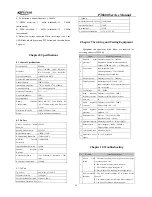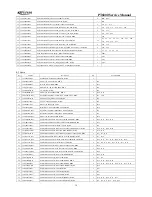
PT6800 Service Manual
4
Figure 4.3 Principle of Power Amplifier and Antenna Switch
The modulated RF signal from VCO is amplified in Q2, Q4,
Q59, Q5, and Q3, and is routed to Q1 for power amplification.
Grid bias of Q1 and Q3 is controlled by the APC circuit.
Through changing the grid bias voltage, the Tx output power
can be controlled conveniently.
APC (Automatic Power Control) Circuit
R57, R65, and R66 are used to test the power amplification
current. IC3A is the sampling amplifier for the power
amplification current. IC3B is the power comparator amplifier.
If the Tx output power is too high, the power amplification
current and IC3A output will increase; IC3B output voltage will
decrease, so the bias voltage of Q1 and Q3 will also decrease,
which causes the Tx output power to be lowered, and vice versa.
Thus the output power of Tx can keep stable under different
working conditions.
MCU can set the power through changing the voltage input
to IC3B.
4.5 Principle of Frequency Synthesizer
Figure 4.4 Frequency Synthesizer
The radio adopts PLL type frequency synthesizer.
The frequency synthesizer consists of reference oscillator,
voltage control oscillator (VCO), programmable divider, phase
comparator, and low pass filter.
Tx VCO unit consists of Q6, D2, D4, D5, and D6. D9 is the
modulation circuit of Tx VCO.
Rx VCO unit consists of Q11, D11, D12, D13, and D14.
IC2 (ADF4111) is the PLL integrated circuit, which consists
of programmable reference divider, programmable divider,
phase comparator, and charge pump.
The low pass filter consists of R43 and C96.
The reference frequency is provided by X1 (TCXO,
12.8MHz).
The reference frequency from TCXO (Temperature
Controlled Crystal Oscillator) is divided by the programmable
reference divider in IC2 to produce reference frequency of
5KHz or 6.25KHz (determined by the preset channel frequency
and is controlled by MCU).
The oscillation frequency from VCO goes to IC2 where it is
divided by the programmable divider and is then compared
with the reference frequency to obtain the error signal. The
signal is then filtered by a low pass filter, and is routed to VCO
to change the oscillation frequency of the VCO, enabling the
frequency to reach the set value. Then the VCO is locked.
Unlock detection: When PLL is unlocked, Pin 14 of IC2
will output the low level signal to MCU. Then MCU prohibits
the Tx from transmitting and makes an alert tone.
Q13 and other relevant circuits are used to switch the low
pass filters.
4.6 Audio Processing Circuit
Figure 4.5 Audio Processing
IC6 (AK2346) is a special voice processing chip, which is
provided with functions of amplification, filtering,
pre-emphasis, de-emphasis, scrambling, companding, MSK
MODEM, etc. Most of the radio’s voice processing is done by
IC6.
MIC Signal Processing
The voice signal coming from the MIC passes through the
AGC circuit, and goes to IC24. One branch of the signal is
routed to IC24B (VOX circuit) for amplification, and then goes
to D35, where it is processed and turned into DC voltage, and
then sent to MCU for processing. The other branch of the signal
is routed to IC24A for amplification, and then goes to pin3 of
IC6, where it is amplified, filtered, companded (optional),
pre-emphasized, scrambled (optional), and limited, and then is
output from pin7 of IC6. After that, the resulting signal is sent
to VCO for modulation together with CTCSS/DCS. The 2T/5T
signal is input to pin6 of IC6. After being limited and amplified,
it is then output from pin7 of IC6, and is routed to VCO for
modulation.
RX Audio Signal Processing
Voice signal output from IC4 is divided into two parts. One
branch of the signal is routed to the low pass circuit consists of
IC5 and other components, where it is amplified and filtered (to
remove the voice signal) to obtain more purified CTCSS/DCS
Summary of Contents for PT6800
Page 28: ...PT6800 Service Manual 27 Figure 3 PT6800 Main Board Top Layer Position Mark Diagram ...
Page 29: ...PT6800 Service Manual 28 Figure 4 PT6800 Main Board Bottom Layer Position Mark Diagram ...
Page 30: ...PT6800 Service Manual 29 Figure 5 PT6800 Main Board Top Layer Position Value Diagram ...
Page 31: ...PT6800 Service Manual 30 Figure 6 PT6800 Main Board Bottom Layer Position Value Diagram ...
Page 33: ...PT6800 Service Manual 32 Figure 8 PT6800 Key Board Top Layer Position Mark Diagram ...
Page 34: ...PT6800 Service Manual 33 Figure 9 PT6800 Key Board Bottom Layer Position Mark Diagram ...
Page 35: ...PT6800 Service Manual 34 Figure 10 PT6800 Key Board Top Layer Position Value Diagram ...
Page 36: ...PT6800 Service Manual 35 Figure 11 PT6800 Key Board Bottom Layer Position Value Diagram ...
Page 40: ...PT6800 Service Manual 39 Figure 16 KBC 60Q Schematic Circuit Diagram ...
Page 41: ...PT6800 Service Manual 40 Figure 17 PCB Layout 1 ...
Page 42: ...PT6800 Service Manual 41 Figure 18 PCB Layout 2 ...






































